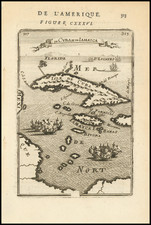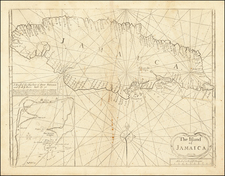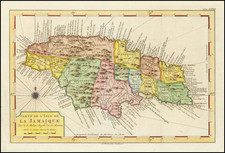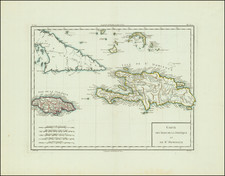Decorative Map of Cuba and Jamaica from Mallet’s Description de l’Univers
The map features a modified bird’s eye view and was made for the Description de l’Univers, the most important publication of military engineer Alain Manesson Mallet.
The map focuses on Cuba and Jamaica, which both have several settlements and ports labeled. It also includes other nearby islands. These include (although they are not labeled), the Cayman Islands south of Cuba.
To the north, Florida is just visible on the horizon. So are the Lucayes, or the Bahamas. The mainland peeks out of the frame to the west and south.
Several ships dot the horizon, a reference to the busy trade that characterized the region and which was underwritten by slave labor. South of Jamaica are two sets of ships locked in battle. Their broadsides have created great clouds of smoke.
The map was included as a plate in Mallet's monumental Description de l' Univers. The work was first published in Paris in 1683 as is perhaps the greatest work of its kind in the seventeenth century.
Alain Mannesson Mallet (1630-1706) was a French mapmaker and engineer who served in the armies of Louis XIV. After rising through the ranks, Mallet was appointed as Inspector of Fortifications, a job which also required mathematical skills and which made him a competent military engineer. Eventually, he joined the court of Louis XIV at Versailles, where he taught math and focused on writing.
Mallet is best known for his Description de L’Univers, first published in 1683, in five volumes. A wide-ranging geographical work, the Description included textual descriptions of the countries of the world, as well as maps of the celestial sky and the ancient and modern worlds. The Description continued to be published until the early eighteenth century. He also published a work in three volumes on warfare (1684) and a primer on geometry (1702).










![Chart of the Bahama Islands [with] The Bermudas or Summer Islands [with] Island of Cuba](https://storage.googleapis.com/raremaps/img/small/83752.jpg)

![[Florida Keys, Cuba, Bahamas, Cayman Islands] The Island of Cuba with part of the Bahama Banks & the Martyrs . . .](https://storage.googleapis.com/raremaps/img/small/85166.jpg)
![[Jamaica] L'Isle de la Jamaique. par M. T. J. Ingenieur Anglois a Paris, 1779](https://storage.googleapis.com/raremaps/img/small/91165.jpg)

